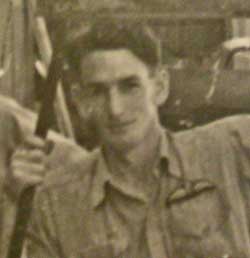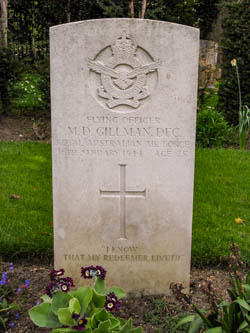Mervyn Durham Gillman DFC
1919 -1944

Mervyn Holly Durham Gillman was born in York, Western Australia on the 19th December 1919. He was the son of Frederick Richard Hoops (1885-1977) and Emilie later spelt Emily) Opal Durham (1895-1975).
Frederick Richard Hoops was a great grandson of Peter Broun (Brown), Western Australia's first Colonial Secretary. Peter Nicholas Broun (1797-1846) arrived in WA in June 1829 on the barque Parmelia with Captain Stirling.
Emily (Em) was the daughter of Thomas Buston Durham J.P. (1859 – 1951), a customs officer and later the Chief Inspector of Liquor in Western Australia and; Emily Anne (or Ann) Durham nee Gwynne (1859 - 1928).
When Mervyn's mother married Rev Charles Denne Gillman (1887-1963) in 1929 his surname changed. His step-father was involved with the establishment of the Church of St Denys at a soldier settlement at Amiens in Queensland in 1923. Later he was a chaplain in WW2.
Mervyn was educated at Warwick State School (Queensland) and later the Church of England Grammar School (Churchie) in Brisbane from April 1936 until the end of 1937. He represented the school in both tennis and cricket. A member of the school cadet unit 1936-1937 where he attained the rank of sergeant and was in charge of the 3rd Platoon in 1937. In 1936 he was the Runner Up - High Jump event in the school athletics championships. In the following year he was 3rd in the 880 yards race in the championships.
He was a student at the University of Queensland from 1938 until he enrolled in the armed forces in 1939.
He married Isabel Jean Taubman Blackwell on 13 May 1942 in St Martin's Church, Killara, NSW.
Mervyn enlisted in the army in 1939 (9/49 Battalion) before transferring to the RAAF in August 1940. In 1942 (while a sergeant) designed and built an anti-aircraft gun mount with periscopic sighting and remote control ("the Gillman Gun Mounting"). The design provided protection for the gunner. After consideration by both the air force and the army the mounting was not put into production.
He embarked from Sydney for the UK in May 1942. In May 1943 he was commissioned as a Pilot Officer and posted to 12 Squadron at RAF Wickenby, UK.
Mervyn Gillman's Lancaster Bomber Operational Flights with 12 Squadron RAF Wickenby
| 13 February 1943 | Paris (nickel) |
| 20th April 1943 | Stettin (Szczecin) |
| 26th April 1943 | Duisburg |
| 30th April 1943 | Essen |
| 12th May 1943 | Duisburg |
| 13th May 1943 | Bochum |
| 23rd May 1943 | Dortmund |
| 25th May 1943 | Dusseldorf |
| 27th May 1943 | Essen |
| 29th May 1943 | Wuppertal |
| 11th June 1943 | Dusseldorf |
| 12th June 1943 | Bochum |
| 14th June 1943 | Oberhausen |
| 3rd July 1943 | Cologne |
| 8th July 1943 | Cologne |
| 12th July 1943 | Turin |
| 2nd August 1943 | Hamburg |
| 7th August 1943 | Genoa |
| 10th August 1943 | Nuremberg |
| 12th August 1943 | Milan |
| 15th August 1943 | Milan |
| 22nd August 1943 | Leverkusen |
| 3rd September 1943 | Berlin |
| 5th September 1943 | Mannheim |
| 22nd September 1943 | Hanover |
| 23rd September 1943 | Mannheim |
| 27th September 1943 | Hanover |
| 3rd October 1943 | Kassel |
| 4th October 1943 | Frankfurt |
| 20th October 1943 | Leipzig |
The members of the crew were the navigator, pilot officer H.W. (Bert) Pearson DFC; bomb aimer, Seargant Roy William Bell; wireless operator Seargent J George Anderson; flight engineer Seargent Leonard William Smith (Smithy); mid upper gunner, Flight Seargant William (Billy) Ross Wicks, DFM (RAAF), killed in action 27th September 1943, age 21; and the rear gunner, Seargent Andrew Stanley (Stan) Miller, DFM (RNZAF). Note: Billy Wicks grew up in the Inverell district in the New England Tablelands in New South Wales. He is buried in Cambridge City Cemetery.
A bomber pilot's first significant flight was known as a "nickel" and did not inolve the dropping of live bombs. Usually paper in the form of propaganda leaflets was dropped instead. Mervyn Gillman's nickel flight probably originated from Seighford.
Later Roy Bell's wife, Ellen, was to recall Mervyn as a charming and attractive man, very sociable, and full of life. As the "skipper", he spent a good deal of his time away from his crew with other pilots. Roy Bell described Mervyn as a "a bloody good pilot" and his daughter said "It was his [Mervyn's] skill that ensured dad survived the war".
In October 1943 his awarded the Distinguished Flying Cross. The citation read:
Pilot Officer Gillman is an exceptionally able captain of aircraft who has consistently completed successful sorties during his operational tour. On a recent raid on Hamburg he displayed outstanding determination to reach and bomb the target. He was compelled to fly through very adverse weather on the outward journey and after reaching the objective he searched for twenty minutes before establishing the target and releasing his bombs. This officer's skilful handling of aircraft and splendid record of achievement have been an example to all in the squadron
His final posting (December 1943) was to No 11 Base at Lindholme. Mervyn Durham Gillman was killed in a flying accident, travelling from Ludford Magna to Seighford in an Oxford Mach 1 to attend the wedding of a member of his crew, Roy William Bell. Roy and his wife Ellen were married the next day but were not told of Mervyn's death until after the wedding. At 6pm on the 16th January 1944, the wing of his aircraft hit a tree two miles west of Church Lawford (about 8 miles southeast of Coventry) after failed attempts to land in thick fog (visability 100 yards) at both RAF Church Lawford and RAF Honiley.
He was buried at the Oxford (Botley) Cemetery (Plot I/2 Grave 140) with full service honours. His name appears in the Commemorative Area (panel 122) of the Australian War Memorial, University of Queensland Roll of Honour board and the Anglican Church Grammar School Roll of Honour.

Mervyn's grave in Oxford
The types of aircraft he flew were DH 82, Avro Anson, Oxford, Wellington, Halifax and Lancaster. It was noted that type of aircraft he was most proficient at flying was the Lancaster.
His DFC was presented to his wife, Isabel, by the then Governor-General (Henry, Duke of Gloucester) at Government House Sydney on the 16th February 1946.
Acknowledgments
David Park, former student of Anglican Grammar School, Brisbane
Olwen Johnson, relative of Roy Bell
References
Roy Bell [originally http://www.aujs06.dsl.pipex.com/12squadron/html/bell.htm, accessed 12 November 2006]
Australian War Memorial website accessed January 2008
Australian War Memorial Series (AWM) 65/2310 GILLMAN Mervyn Durham 404333
Commonwealth War Graves Commission website accessed 12 November 2006
Johnson, Olwen (2007) Personal communication
National Archives of Australia (NAA)A705 Gillman M R 404333
National Archives of Australia (NAA)A9300 GILLMAN M D
National Archives of Australia (NAA) B4747 GILLMAN/MERVYN DURHAM
National Archives of Australia (NAA) MP76/1/0, [Inventor/Submitter -] M D Gillman - MG [machine gun] mount with periscopic sight and remote control [includes two drawings and photographs]
Park, David (2006). Personal communication